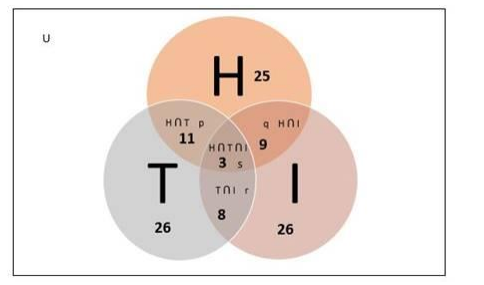In a survey of 60 people, it was found that 25 people read newspaper H, 26 read newspaper T, 26 read the newspaper I, 9 read both H and I, 11 read both H and T, 8 read both T and I, and 3 read all the three newspapers. Find
(i) The number of people who read at least one of the newspapers,
(ii) The number of people who read exactly one newspaper.
Given:
- Total number of people $=60$
- Number of people who read newspaper $\mathrm{H}=25$
- Number of people who read newspaper $\mathrm{T}=26$
- Number of people who read newspaper $I=26$
- Number of people who read newspaper $\mathrm{H}$ and $\mathrm{I}$ both $=9$
- Number of people who read newspaper $\mathrm{H}$ and $\mathrm{T}$ both $=11$
- Number of people who read newspaper $T$ and $I$ both $=8$
- Number of people who read all three newspapers $=3$
To Find:
(i) The number of people who read at least one of the newspapers
Let us consider,
Number of people who read newspaper $\mathrm{H}=\mathrm{n}(\mathrm{H})=25$
Number of people who read newspaper $\mathrm{T}=\mathrm{n}(\mathrm{T})=26$
Number of people who read newspaper $I=n(I)=26$
Number of people who read newspaper $\mathrm{H}$ and $\mathrm{I}$ both $=\mathrm{n}(\mathrm{H} \cap \mathrm{I})=9$
Number of people who read newspaper $\mathrm{H}$ and $\mathrm{T}$ both $=\mathrm{n}(\mathrm{H} \cap \mathrm{T})=11$
Number of people who read newspaper $T$ and $I$ both $=n(T \cap I)=8$
Number of people who read all three newspapers $=\mathrm{n}(\mathrm{H} \cap \mathrm{T} \cap \mathrm{I})=3$
Number of people who read at least one of the three newspapers $=n(H U$ U U I)
Venn diagram:

We know that,
$n(H U T U I)=n(H)+n(T)+n(I)-n(H \cap I)-n(H \cap T)-n(T \cap I)+n(H \cap T \cap I)$
$=25+26+26-9-11-8+3$
$=52$
Therefore
Number of people who read at least one of the three newspapers = 52
(ii) The number of people who read exactly one newspaper
Number of people who read exactly one newspaper =
$\mathrm{n}(\mathrm{HU} \mathrm{U} \mathrm{U} \mathrm{l})-\mathrm{p}-\mathrm{q}-\mathrm{r}-\mathrm{s}$
Where,
$p=$ Number of people who read newspaper $H$ and $T$ but not $I$
$q=$ Number of people who read newspaper $H$ and $I$ but not $T$
$r=$ Number of people who read newspaper $T$ and $I$ but not $H$
$s=$ Number of people who read all three newspapers $=3$
$p+s=n(H \cap T) \ldots(1)$
$q+s=n(H \cap I) \ldots(2)$
$r+s=n(T \cap I) \ldots(3)$
Adding $(1),(2)$ and $(3)$
$p+s+q+s+r+s=n(H \cap T)+n(H \cap I)+n(T \cap I)$
$p+q+r+3 s=9+11+8$
$p+q+r+s+2 s=28$
$p+q+r+s=28-2 \times 3$
$p+q+r+s=22$
Now,
$n(H U \top U I)-p-q-r-s=n(H U T U I)-(p+q+r+s)$
$=52-22$
$=30$
Hence, 30 people read exactly one newspaper
Click here to get exam-ready with eSaral
For making your preparation journey smoother of JEE, NEET and Class 8 to 10, grab our app now.
